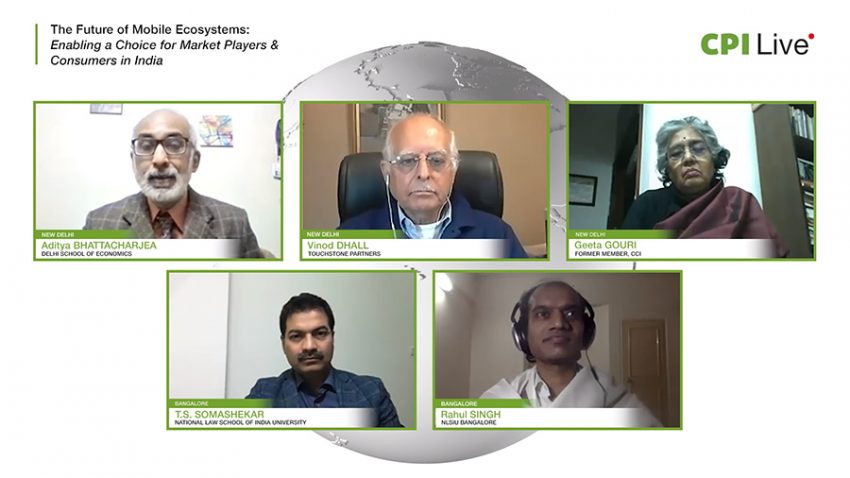The Future of Mobile Ecosystems: Enabling a Choice for Market Players & Consumers in India (Program Synthesis)
BACKGROUND NOTE:
- The Competition Commission of India (CCI) has launched an investigation in relation to the OS market for mobile handsets, examining allegations of self preferencing by the app stores and OS owners. Earlier, it has imposed penalties to the tune of USD 21 million in a case relating to online web search and web search advertising services.
- In addition to keeping an eye on the conduct cases, the CCI has been actively seeking to enhance its ability to scrutinise global tech mergers that currently escape its net due to scheme of the competition statute.
Panel Summary
The Panel discussed few themes relevant to the Indian mobile phone ecosystem, such as the need to understand the business model of the digital players and the unique features of the Indian mobile ecosystem, need to give primacy to consumer welfare while addressing competition concerns, and having a nuanced approach with respect to assessment of consumer harm. The Panel also cast a spotlight on the issue of Indian competition agency following the footsteps of its western counterparts and the merits / demerits of such approach.
The Panel was moderated by Aditya Bhattacharjea (Delhi School of Economics, University of Delhi) who noted that the Competition Commission of India (CCI) has taken a rational and not a ‘per se’ approach in interpreting the abuse of dominance provisions. He also raised the concern that if one accepts the proposition that digital economy is naturally inclined towards a ‘rule of three’ or ‘winner takes it all’ scenario (as suggested by Geeta Gouri), if there is merit in promoting homegrown players. On this point of digital protectionism, he remarked that consumer welfare should be the end goal regardless of domicile of the firms involved.
Turning to the Panel, first, Vinod Dhall (Touchstone Partners) highlighted certain key features of the mobile ecosystem such as network effects, being data and innovation driven, that make application of traditional competition tools to this sector problematic. He highlighted then need to study overall effects of the activities and being cautious of drastic remedies given the massive consumer welfare generated by the sector. Geeta Gouri (Formerly, CCI) and Rahul Singh (NLSIU Bangalore) echoed the sentiment with respect to need for caution in respect of regulating this sector and the need to understand the peculiarities of the business model of the players, and to be wary of digital protectionism.
On the issue of reliance of the CCI on the case laws and trends in the EU, Geeta Gouri and Vinod Dhall differed. While the former suggested that CCI should recognise that Indian market and consumer is very different from its western counterpart, Vinod Dhall posited that competition concerns and remedies are globally are broadly similar, which gives the appearance of the lock step movement of EU and Indian competition regimes. In this context, remarks of Rahul Singh were opportune who invoked Mahatma Gandhi to suggest that while one should be open to all streams of knowledge, one should not be swept away by them. He also highlighted that one needs to view the markets from the perspective of the consumer (public choice theory) and also factor in exit barriers for consumers (and not just entry barriers for competitors).
T S Somashekhar (National Law School of India) highlighted the issue of information asymmetry that affects efficacy of the regulators in the sector. He, then, examined the dominance of Google’ Android OS in the Indian mobile ecosystem and posited that both exclusionary and exploitative conduct of the dominant firm need to be examined. He cited several instances where the actions of Google and Apple with respect to their respective app stores (such as removal of certain apps, charging a fees on app developers, preferring homegrown apps) were questionable.

Key Talking Points | Vinod Dhall
- Special Features of the Mobile Phone Ecosystem:
(i) Economies of scale (i.e. bigger a player, lesser is the cost of acquiring new customer)
(ii) Economies of scope (e.g. Amazon offering Amazon cloud services, Amazon prime, etc. and Google offering Google Play, Google Search, Google Maps, Chrome, Gmail, etc.),
(iii) Technology and innovation as key drivers (innovation cycle in this market is reportedly one of the shortest, i.e. 3 years),
(iv) Network externalities,
(v) Being data driven, and
(vi) Different services in the ecosystem are intertwined.
- Challenges in Regulating Mobile Phone Ecosystem
High entry barriers: Interplay of the aforementioned factors, together with use of artificial intelligence for harnessing data by the incumbent players, creates entry barriers for new entrants and leads to foreclosure of market.
Traditional tools of analysis inapplicable: Traditional principles of competition law and economics (such as relevant market definition and market dominance) cannot be applied to digital markets given its special features.
- Policy Recommendations:
Study the effects: Overall effect (exclusionary and exploitative) of activities of digital firms should be examined, instead of focussing on the concepts of relevant market and dominance of firms.
Presumption of anti-competitive conduct: The onus of proving that a particular impugned conduct is not anti-competitive should be shifted on the firms and there should be a prima facie presumption against the defendants,
No Splintering: Splitting of tech companies should not be the default remedy.
Platforms as semi regulators: Big platforms have regulatory responsibility as well where they ensure that other users of the platform (including the platforms themselves) are transparent, fair and non- discriminatory. The big platforms need to eschew self preferencing activities.
- On Borrowing from the EU Model:
Competition law embodies universal principles that are similar across jurisdictions and similar type of competition challenges end up following similar outcomes. This largely explains why India has been ostensibly following the EU trajectory in regulation of the digital platforms.
“…the problems are similar and the weapons available to the competition authorities are similar, but in my view in such a high innovation-driven, technology-driven industry, forbearance and restraint in using the authority’s powers is also extremely important…” – Vinod Dhall

Key Talking Points | Dr. Geeta Gouri
- European Bias in Indian Competition Law:
The CCI has a tendency to follow the EU competition cases even as the Indian consumer and business landscape is very different than its European counterparts. It has been suggested that the EU has a bias against American firms and by following the EU competition decisions, India ends up importing the anti-American bias.
There are several reasons why reliance on EU jurisprudence is a sub optimal approach for the CCI. In the Indian context, to establish an abuse of dominance case, one needs to categorise the impugned conduct, define the relevant market, establish dominance therein and then assess harm. In the European context, the classification of impugned conduct is often not undertaken and the analysis begins from the stage of delineation of the relevant market. Another reason is that Indian market and consumer are very different from the European counterparts.
- Indian Mobile Ecosystem Landscape:
India has robust innovation in the digital and mobile space with many home grown apps, an indigenous OS and high mobile usage in small towns as well. This indicates that barriers to entry in the space are not that high as suggested.
- Digital Protectionism & Consumer Welfare Standard:
There are proposals to levy equalisation tax and an explicit tendency towards protectionism of Indian companies in the digital space, including mobile telephony, where the prerogative and subjective discretion lies entirely with the Indian government. Often, competitors bring competition cases as a strategic tool rather than genuine grievance redressal tool. One needs to be mindful how such policies, if enacted, would impact the consumers. The Competition Act is premised on total welfare standard and not protection of the competitors.
- Understanding the Business Model:
One has to understand the business model of the digital players. Businesses are fundamentally incentivised to make something that is exclusive or difficult to replicate. Each business is driven by its business motives. The market is characterised by disruptive technology and innovation. The fact that there is continuous innovation proves that there is a competitive constraint in the digital markets.
Owing to network effects and platform economics in the digital space, market concentration is almost inevitable. There is tipping tendency where the ‘winner takes it all’ that is inherent in the business model in the digital space.
- Policy Recommendations:
The CCI needs to examine cases with its own lens, untinted by the EU experience.
The CCI needs to place emphasis on the consumer welfare standard and not veer towards protection of the competitors.
The per se approach in Section 4 of the Act (that deals with abuse of dominance cases) needs to be reassessed.
“…for a regulator, it is very important to be careful not stepping and kill everything by being overprotective…” – Dr. Geeta Gouri

Key Talking Points | Rahul Singh
- Mobile Ecosystem Overview:
The mobile ecosystem has three key components viz. the hardware (mobile phone instruments, ipads, tablets, etc.), the operating systems and application stores; and the microprocessors or chips. In the Indian context, we are concerned largely with the hardware and the operating system and the app store.
Regulatory response needs to be deliberative and not intuitive.
- Indian Competition Jurisprudence:
The Indian competition jurisprudence borrows heavily from its European and American counterparts. Given that the Indian Competition Act was enacted in 2002, received presidential assent in 2003, the enforcement provisions became effective in 2009 and the merger control provisions took effect in 2011, and that the CCI has since decided around 1500 cases, it is legitimate to question whether, at this stage, over reliance on foreign jurisprudence is merited at all.
- Consumer Welfare Standard:
The Competition Act, 2002 defines ‘consumer’ and not ‘competition’. While regulating the digital companies, one needs to consider the impact of the regulation on the consumers and acknowledge that humans (as consumers) are rational actors that mostly act in self-interest (as posited by the public choice theory).
- Open Minded Approach:
One needs to be open minded, have a cross disciplinary approach towards competition analysis and engage experts from different fields. Equally, while borrowing from other jurisdictions, one must be grounded in the instant realities.
- Contestability of Markets:
There is a popular argument that that mobile ecosystem has high entry barriers. In this context, one needs to look at contestability of markets from the perspective of absence of exit barriers as well i.e. whether a consumer can use and exit a platform freely.
“…are we really moving from, let’s say fast intuitive thinking, to slow deliberative sort of analysis? The second question which I had asked was let’s say instead of looking at other countries as a source of our jurisprudence, is it time to look at our own? Let’s say Indian competition jurisprudence, if it is, what will that be based upon? And the third question is, is it time to also look at, from the perspective of, public choice theory to go on to the standard of consumer welfare?” – Rahul Singh

Key Talking Points | T.S. Somashekar
- Information Asymmetry:
The business model and market practices of tech companies changes even before the regulator has had a chance to catch up. This becomes a challenge for the regulator.
- Assessment of Dominance of Google’s Android in India:
In India, Android has around 96% market share with around 700 million unique smartphone users. Google’s Android has ‘significant’ market power in this market in India since smartphone manufacturers primarily use Google’s Android. Other than market share, the consumers or app developers don’t have countervailing market power. Notably, Samsung failed at developing its own OS.
Market power allows an actor to act independently of the market through ‘exploitative’ and / or ‘exclusionary’ conduct.
- Assessment of Abuse of Dominance by Google with Respect to Android OS:
One needs to assess whether Google has abused its dominant position in OS market in India. It may be argued that the proposal to levy entry fees for app developers would be exploitative. If so, one needs to answer what would be a ‘fair price’ and at which threshold of pricing does the levy cease to be exploitative.
Practices such as requiring the app developers to pay for favourable ranking placement of their apps in the app store, or removing certain competitor apps from the playstore without adequate justification allude to exclusionary conduct by Google. There is a need to level this playing field, else the market will be dominated only by tech giants and conglomerates.
- The innovation Counterfactual:
Would innovations have been more robust in the digital space, if not for the dominance of Google’s Android, or globally iOS and Android. Notably, Android was an acquisition that was substantially worked upon by Google post acquisition.
“…We face a huge, enormous, information asymmetry. We have no clue what these tech companies are doing. The regulators, by the time they catch up to find out what the tech companies are up to they are already in a lag again because the latter have adopted something else. That is something that we must realize when we tackle this particular scenario…” – T.S. Somashekha
Featured News
Google and South Carolina Clash Over State Records Demand
May 8, 2024 by
CPI
Telefonica Germany Teams Up with Amazon Web Services to Migrate 5G Customers
May 8, 2024 by
CPI
Federal Judge Grants $7.4 Million Settlement in Pork Price-Fixing Case
May 8, 2024 by
CPI
Wilson Sonsini Bolsters Antitrust and Competition Practice with Key Partner Returns
May 8, 2024 by
CPI
EU to Scrutinize Telecom Italia’s Network Sale to KKR
May 8, 2024 by
CPI
Antitrust Mix by CPI
Antitrust Chronicle® – Economics of Criminal Antitrust
Apr 19, 2024 by
CPI
Navigating Economic Expert Work in Criminal Antitrust Litigation
Apr 19, 2024 by
CPI
The Increased Importance of Economics in Cartel Cases
Apr 19, 2024 by
CPI
A Law and Economics Analysis of the Antitrust Treatment of Physician Collective Price Agreements
Apr 19, 2024 by
CPI
Information Exchange In Criminal Antitrust Cases: How Economic Testimony Can Tip The Scales
Apr 19, 2024 by
CPI
